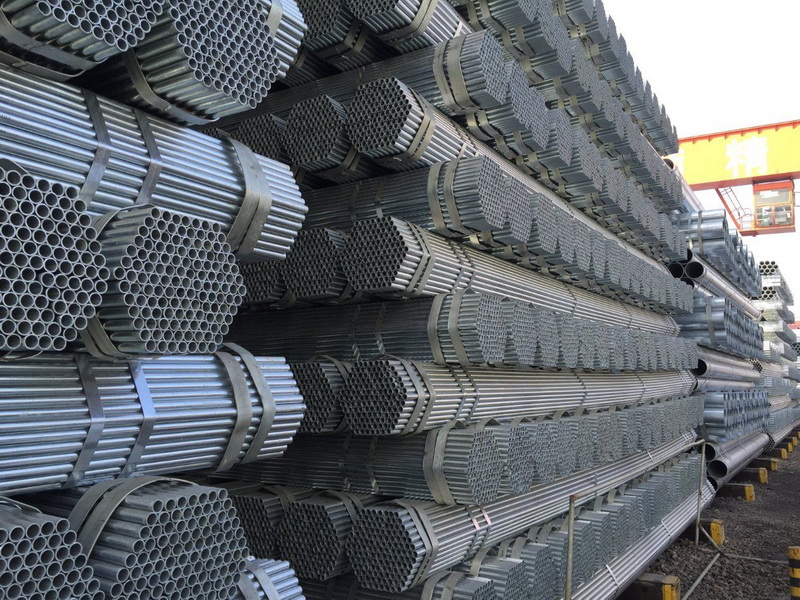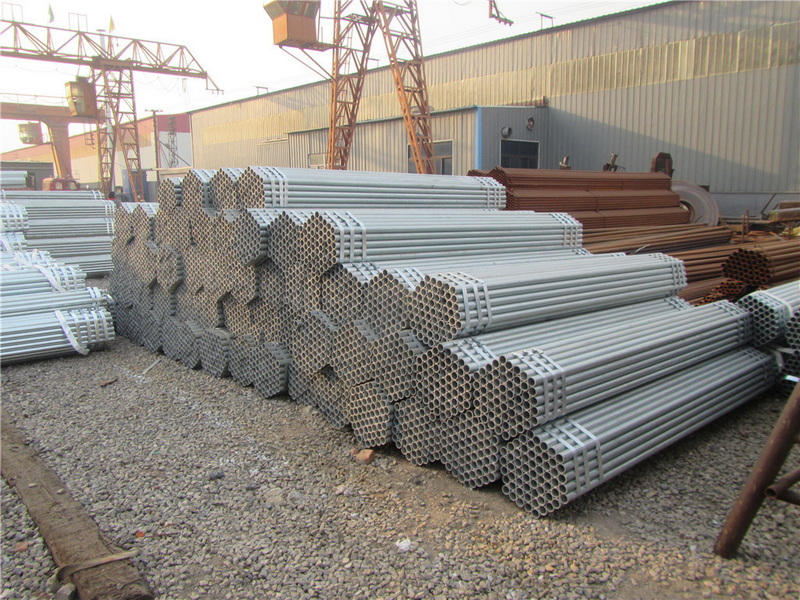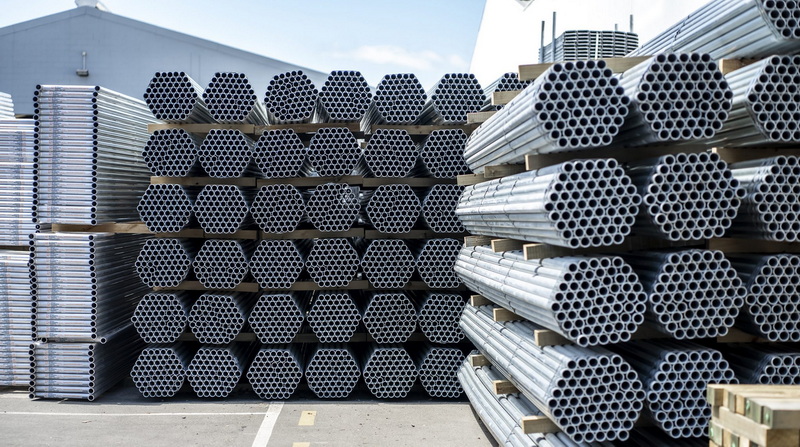Content Menu
● Understanding BS1139 Scaffolding Tubes
● Overview of the Production Process in BS1139 Scaffolding Tube Factories
● 1. Raw Material Selection and Inspection
>> Steel Coil Procurement
>> Raw Material Testing
● 2. Tube Forming and Welding
>> Tube Forming
>> Welding Process
>> Weld Seam Inspection
● 3. Heat Treatment and Straightening
>> Heat Treatment
>> Straightening
● 4. Surface Preparation and Cleaning
>> Pickling
>> Surface Cleaning
● 5. Hot-Dip Galvanizing (HDG)
>> Galvanizing Process
>> Cooling and Inspection
● 6. Final Inspection and Quality Control
>> Dimensional Checks
>> Mechanical Testing
>> Certification and Traceability
● 7. Packaging and Shipping
● Additional Quality Assurance Practices in BS1139 Scaffolding Tube Factories
>> Welding Line Monitoring
>> Flattening Test
>> Corrosion Resistance Testing
>> Straightness and Ovality Checks
>> Documentation and Traceability
● Environmental and Safety Considerations in BS1139 Scaffolding Tube Factories
>> Environmental Management
>> Worker Safety
● Visual Summary of BS1139 Scaffolding Tube Production Process
● Conclusion
● FAQ
>> 1. What raw materials are used in BS1139 scaffolding tube factories?
>> 2. How is the weld seam quality ensured during production?
>> 3. Why is hot-dip galvanizing important in BS1139 scaffolding tubes?
>> 4. What are the key dimensional tolerances for BS1139 scaffolding tubes?
>> 5. How do BS1139 scaffolding tube factories ensure traceability?
The production of scaffolding tubes that meet the BS1139 standard is a highly specialized and controlled process. BS1139 scaffolding tube factories must follow stringent quality and manufacturing protocols to ensure that the tubes are safe, durable, and compliant with British standards. These tubes are critical components in construction scaffolding systems, and their production involves multiple stages from raw material selection to final inspection.

Understanding BS1139 Scaffolding Tubes
Before diving into the production process, it is essential to understand what BS1139 scaffolding tubes are and why their production demands such precision.
- BS1139 is a British Standard specifying the requirements for scaffolding tubes and fittings.
- Tubes must have an outer diameter of 48.3 mm (± 0.5 mm) and wall thicknesses typically ranging from 3.2 mm to 4.0 mm.
- The tubes are made from steel or hot-dip galvanized steel to ensure corrosion resistance and mechanical strength.
- They must meet strict hardness, tensile strength, and straightness requirements.
- These tubes are used extensively in construction scaffolding systems for their reliability and safety.
Overview of the Production Process in BS1139 Scaffolding Tube Factories
The production of BS1139 scaffolding tubes involves the following key stages:
1. Raw Material Selection and Inspection
2. Tube Forming and Welding
3. Heat Treatment and Straightening
4. Surface Preparation and Cleaning
5. Hot-Dip Galvanizing (HDG)
6. Final Inspection and Quality Control
7. Packaging and Shipping
Each stage is critical to achieving the desired mechanical properties and dimensional accuracy required by BS1139.
1. Raw Material Selection and Inspection
Steel Coil Procurement
- The production begins with the procurement of high-quality steel coils, usually made from Q235, Q345, or equivalent steel grades that comply with BS1139 standards.
- The steel must have the correct chemical composition, tensile strength, and elongation properties.
Raw Material Testing
- In-house laboratories in BS1139 scaffolding tube factories conduct chemical composition analysis and mechanical property tests on steel coils.
- This ensures the steel meets the BS1139 requirements for hardness, tensile strength, and ductility.
- Only steel coils that pass these tests are accepted for production.
2. Tube Forming and Welding
Tube Forming
- The steel coil is fed into an automated roll forming machine that gradually bends the flat steel into a cylindrical shape.
- The forming process is precise to ensure the tube diameter is consistently 48.3 mm ± 0.5 mm.
Welding Process
- The edges of the formed tube are joined by a high-frequency electric resistance welding (ERW) process.
- This welding technique produces a strong, uniform seam that meets BS1139 mechanical strength requirements.
- The weld seam is continuously monitored for defects.
Weld Seam Inspection
- Visual and ultrasonic inspections detect any weld imperfections such as cracks or inclusions.
- Defective tubes are rejected or reprocessed.
3. Heat Treatment and Straightening
Heat Treatment
- Some factories apply heat treatment to relieve internal stresses caused by welding.
- This process improves the tube's mechanical properties and dimensional stability.
Straightening
- Tubes are passed through straightening machines to ensure the maximum deviation from straightness does not exceed 3 mm per meter, as required by BS1139.
- Straight tubes are essential for safe and stable scaffolding assembly.
4. Surface Preparation and Cleaning
Pickling
- Tubes undergo a pickling process to remove mill scale, rust, and other impurities.
- This involves immersing the tubes in acid baths followed by thorough rinsing.
Surface Cleaning
- After pickling, tubes are cleaned with solvents to prepare for galvanizing.
- Clean surfaces ensure proper adhesion of the zinc coating.
5. Hot-Dip Galvanizing (HDG)
Galvanizing Process
- Tubes are dipped into a bath of molten zinc at approximately 450°C.
- This creates a uniform, corrosion-resistant zinc coating that protects the steel from rust and environmental damage.
- The coating thickness and adhesion are carefully controlled to meet BS1139 standards.
Cooling and Inspection
- After galvanizing, tubes are cooled and inspected for coating uniformity and defects.
- Any tubes with insufficient galvanizing are rejected or reprocessed.
6. Final Inspection and Quality Control
Dimensional Checks
- Final measurements of outer diameter, wall thickness, and length are taken using digital calipers and ultrasonic thickness gauges.
- Tubes must conform to BS1139 tolerances: diameter 48.3 mm ± 0.5 mm, wall thickness 3.2 to 4.0 mm ± 10%.
Mechanical Testing
- Tensile strength, hardness, and flattening tests are performed on sample tubes.
- Weld seam integrity is verified through non-destructive testing.
Certification and Traceability
- Each batch of scaffolding tubes is accompanied by mill certificates and test reports.
- This documentation proves compliance with BS1139 and ensures traceability.
7. Packaging and Shipping
- Finished scaffolding tubes are bundled and securely packaged to prevent damage during transport.
- Labels include specifications, batch numbers, and compliance certificates.
- Proper packaging ensures tubes arrive at construction sites in perfect condition.

Additional Quality Assurance Practices in BS1139 Scaffolding Tube Factories
Welding Line Monitoring
- Continuous monitoring of welding parameters such as current, voltage, and speed ensures consistent weld seam quality.
- Automated systems can detect deviations and alert operators for immediate correction.
Flattening Test
- Tubes are subjected to flattening tests where a section is compressed to check weld seam strength and ductility.
- The tube must not crack or fracture, demonstrating weld integrity.
Corrosion Resistance Testing
- Samples undergo accelerated corrosion tests such as salt spray to verify the durability of the galvanizing.
- This ensures the tubes will withstand harsh environmental conditions on construction sites.
Straightness and Ovality Checks
- Tubes are checked for straightness and ovality (roundness) to ensure they fit properly with clamps and couplers.
- Ovality beyond limits can cause assembly issues and compromise scaffold stability.
Documentation and Traceability
- Detailed records of production parameters, test results, and batch numbers are maintained.
- This ensures full traceability and accountability, critical for quality assurance and regulatory compliance.
Environmental and Safety Considerations in BS1139 Scaffolding Tube Factories
Environmental Management
- BS1139 scaffolding tube factories implement environmental controls to manage emissions, waste, and water usage.
- Wastewater from pickling and galvanizing is treated to remove harmful chemicals.
- Recycling of steel scrap and zinc is common to reduce environmental impact.
Worker Safety
- Manufacturing processes involve high temperatures, heavy machinery, and hazardous chemicals.
- Strict safety protocols, personal protective equipment (PPE), and training programs protect workers.
- Regular safety audits and equipment maintenance minimize risks.
Visual Summary of BS1139 Scaffolding Tube Production Process
| Step | Description | Key Quality Checks |
| Raw Material Inspection | Steel coil testing for chemical & mechanical properties | Chemical composition, tensile strength |
| Tube Forming & Welding | Roll forming and ERW welding of tubes | Diameter, weld seam integrity |
| Heat Treatment & Straightening | Stress relief and straightening | Straightness deviation ≤ 3mm/m |
| Surface Preparation | Pickling and cleaning | Surface cleanliness |
| Hot-Dip Galvanizing | Zinc coating for corrosion resistance | Coating thickness and adhesion |
| Final Inspection | Dimensional and mechanical testing | Diameter, thickness, tensile, hardness |
| Packaging | Bundling and labeling for shipment | Damage-free packaging |
Conclusion
The production process in BS1139 scaffolding tube factories is a meticulous and multi-stage operation designed to produce scaffolding tubes that meet stringent British standards. From selecting high-quality steel coils to precision forming, welding, galvanizing, and rigorous quality control, every step is vital to ensure the tubes' safety, durability, and compliance.
Adhering to the BS1139 standard guarantees that scaffolding tubes will perform reliably in demanding construction environments, providing a safe working platform for workers. The combination of advanced manufacturing technology and strict quality assurance practices in BS1139 scaffolding tube factories ensures the highest product quality and customer satisfaction.
By continuously improving production techniques and maintaining rigorous quality controls, BS1139 scaffolding tube factories contribute significantly to the safety and success of construction projects worldwide.

FAQ
1. What raw materials are used in BS1139 scaffolding tube factories?
High-quality steel coils, typically Q235 or Q345 grade steel, are used. These materials must meet BS1139 chemical and mechanical property requirements.
2. How is the weld seam quality ensured during production?
Weld seams are produced using high-frequency electric resistance welding (ERW) and inspected visually and ultrasonically to detect defects.
3. Why is hot-dip galvanizing important in BS1139 scaffolding tubes?
Hot-dip galvanizing provides a protective zinc coating that prevents corrosion, extending the tube's service life in harsh environments.
4. What are the key dimensional tolerances for BS1139 scaffolding tubes?
Outer diameter must be 48.3 mm ± 0.5 mm, wall thickness between 3.2 mm and 4.0 mm with ±10% tolerance, and straightness deviation not exceeding 3 mm per meter.
5. How do BS1139 scaffolding tube factories ensure traceability?
Each batch of tubes is accompanied by mill certificates and test reports documenting compliance with BS1139 standards, ensuring full traceability.






















